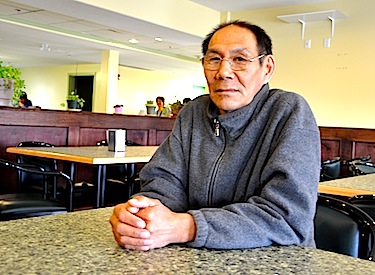Makeshift Nunavut morgues need replacing: mayors
“It’s a big problem this time of the year when the weather gets warmer”

Hall Beach mayor Ammie Kipsigak says the bodies of deceased residents in his community are kept in a RCMP shack under their burial. He would like help from the GN to establish a more official morgue facility n his and other Nunavut communities. (PHOTO BY SARAH ROGERS)

The bodies of Iqaluit residents who have died outside the hospital are generally kept in the old Baffin regional hospital morgue. The community’s long-time undertaker, Brian Pearson, said it’s time for the territory’s health department to turn the facility’s management over to the city. (PHOTO BY SARAH ROGERS)
Ammie Kipsigak says Nunavut communities need proper morgues.
The mayor of Hall Beach says his community – like many others in Nunavut – has no official facility to hold deceased residents while they await burial.
And that, he says, can cause more grief to families who are already mourning the loss of a loved one.
“It’s a big problem this time of the year when the weather gets warmer,” Kipsigak told Nunatsiaq News. “Whenever there’s a death and the family wants to see the body, we want it to be as good as it can be.”
The bodies of deceased Hall Beach residents — about a half dozen each year — are kept in a local RCMP shack until burial, which Kipsigak says is sufficient through the winter months.
But in warmer months, Kipsigak said a decomposing body is an “eyesore” and difficult for grieving family members to see.
That’s why he has spent the last two years lobbying the Government of Nunavut for help in establishing a morgue facility in Hall Beach and in other communities throughout the territory.
Kipsigak, along with other elected municipal officials, passed a resolution at the Nunavut Association of Municipalities meeting in May, committing the organization to work with the GN to address the problem.
Part of that resolution is to draft up an inventory of communities with existing morgues.
“If [the GN] wants to help us, we can raise some money,” he said. “But our government doesn’t seem to think it’s a priority.”
When Amittuq MLA Louis Tapardjuk probed the premier at the last session of the legislative assembly, Eva Aariak agreed that the absence of morgues in the territory must be dealt with.
But, she said the GN could not make any commitment until it consults with Inuit organizations.
Kipsigak has done the math: he says a two-tray refrigerated morgue unit for his community would run about $30,000, plus the cost of shipping and operating.
The hamlet of Hall Beach would run the facility, he said.
That’s how it’s done in some other Nunavut communities that have morgues.
In Igloolik, the hamlet runs a portable, two-tray morgue unit that is kept in the community’s search and rescue building, and plugged in when needed.
The community also has a second facility, a cold storage room built into Igloolik’s new heath centre.
There are a handful of other new health centres in Nunavut that also have built-in morgues.
In Iqaluit, residents who die in the Qikiqtani General Hospital are kept at the hospital’s morgue until burial.
The bodies of those who die outside the hospital are often kept in a second morgue located at the old Baffin Regional Hospital.
Brian Pearson, Iqaluit’s long-time undertaker, says Nunavut’s health department should turn that facility over to the city to manage.
That could mean cheaper and better access for the family members of the deceased and a longer-term solution in the case of delayed burials, he said.
But another issue is where to put the bodies of deceased people returning to Iqaluit from other communities.
Typically, it’s First Air that transports bodies North, Pearson said, because that airline is “most willing.” He said the airline also donates its refrigeration facilities in Iqaluit to keep the body until burial.
Pearson calls the service “extremely helpful,” since the city of Iqaluit doesn’t provide a facility for bodies waiting for burial.
He said a four-tray facility would be able to accommodate the 30 to 40 Iqalummiut who die each year, plus those from out-of-town.
“There’s no question that a facility should be here,” he said, adding that the need for a staffed facility would be even greater once he retires.
But Pearson calls the absence of morgues in other communities a “non-issue” – particularly for smaller communities that only deal with a handful of deaths every year.
“We manage as it is,” he said. “If there’s ever a major catastrophe – like a plane crash – bodies would be shipped south anyway.”
As for other funeral-related services, such as embalming, cremation or viewings, Pearson said that not even a growing community like Iqaluit could afford to offer those services in the North.
“To have a funeral parlour, you need a steady flow of business, and there just isn’t the population to justify it,” he said.





(0) Comments